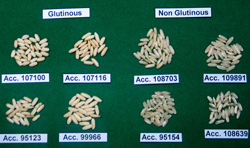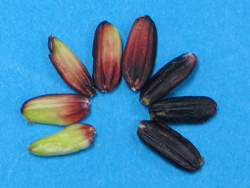Characterization of cultivated rice, wild rice and related genera

Mature open panicle (photo:IRRI) |
Contributors to this page: T.T. Chang Genetic Resources Centre-IRRI, Los Baños, Philippines (Ruaraidh Sackville Hamilton, Ken McNally, Flora de Guzman, Renato Reaño, Soccie Almazan, Adelaida Alcantara, Elizabeth Naredo); WARDA, Cotonou, Benin (Ines Sánchez); UPLB-University of the Philippines at Los Baños (Teresita Borromeo).
|
Contents: |
Planting and cultural practices for characterization
For details on cultivated rice, click here.
For details on wild rice and related genera, click here.
Morphological descriptors for characterization
See list for rice descriptors developed by Bioversity International, IRRI and AfricaRice, (2007) and key access and utilization descriptors for rice genetic resources developed by Bioversity International and International Rice Research Institute (IRRI) (2009).
Pictures for characterization
Sufficient detail should be captured in images to taxonomically identify the plant and demonstrate the traits that show variation.
 From paddy (left) to brown rice (center) to polished rice (right) (photos: IRRI) |
- Take images for character(s) which may be difficult to describe verbally.
- Intact inflorescence.
- Whole grain as harvested (‘paddy’).
- De-hulled unpolished caryopsis (‘brown rice’).
- Polished rice.
- Store in a database file linked to other characterization data.
Herbarium samples for characterization
Use only for wild rice and related genera, where it is useful to have references.
- Sufficient detail should be captured to taxonomically identify the plant and demonstrate the traits that show variation.
- Take and store vouchers for future reference and taxonomic verification.
- Collect plants with leaves, flower spikes and seeds as well as roots.
- Spread plants open before pressing.
Molecular descriptors for characterization
Prior/current:
- Selected SSR markers with allelic controls (protocols for SSR marker technology are established; however, accurate scoring across diverse germplasm presents significant difficulties).
Current/near future:
- SNP genotyping platforms (SNPs arrays have been established, removing issues with scoring quality, and are replacing SSRs as the preferred technology).
Cytological characterization
- Not useful for cultivated rice, which are all diploid with AA genome (in contrast with wild rice species which have a range of genomes).
- Wild rice species are all either diploid (2n=24) or tetraploid (2n=48). Chromosome counts are a valuable aid to taxonomic identification.
- Wild rice species have chromosomes with recognizably different morphologies, classified as AA, BB, ..., KK.
Nutritional traits for characterization
- See list for rice descriptors developed by Bioversity International, IRRI and AfricaRice, 2007.
Recording information during characterization
- See list for rice descriptors developed by Bioversity International, IRRI and AfricaRice, 2007.
 |
 |
|
Grain diversity: grains from Laos |
Showing the different stages of maturity of black caryopsis (photo: IRRI) |
References and further reading
Bioversity International, IRRI. 2009. Key access and utilization descriptors for rice genetic resources. Bioversity International, Rome, Italy; International Rice Research Institute, Philippines. Available here.
Bioversity International, IRRI and WARDA. 2007. Descriptors for wild and cultivated rice (Oryza spp.). Bioversity International, Rome, Italy; International Rice Research Institute, Los Banos, Philippines; WARDA, Africa Rice Center, Cotonou, Benin. Available here. (1.2 MB)
Borromeo TH, Sanchez PL, Vaughan DA. 1994. Wild rices of the
Chakravarthi BK, Naravaneni R, 2006. SSR marker based DNA fingerprinting and diversity study in rice (Oryza sativa L.) [online]. Available from: http://ajol.info/index.php/ajb/article/viewFile/42772/26341. Date accessed: 10 July 2013.
Chang TT, Vaughan DA.1989. Conservation and potentials of rice genetic resources. In: Bajaj YFS, editor. Biotechnology in agriculture and forestry.
Hanson J. 1985. Practical Manuals for Genebanks: Procedures for handling seeds in genebanks. IBPGR, Rome, Italy. HTML version available from: http://www2.bioversityinternational.org/publications/Web_version/188/. Date accessed: 10 July 2013.
IRRI. 2000. Manual of operations and procedures of the International Rice Genebank. Genetic
Korzun V. Molecular markers and their application in cereals breeding [online]. Available from: http://www.fao.org/biotech/docs/Korzun.pdf. Date accessed: 10 July 2013.
Lu BR. 1999. Taxonomy of the genus Oryza (Poaceae): Historical perspective and current status. IRRN 24.3. IRRI, Los Baños, Laguna.
Micro satellite markers [online]. Available from: http://www.gramene.org/markers/microsat/. Date accessed: 10 July 2013.
McNally KL, Bruskiewich R, Mackill D, Buell RC, Leach JE and Leung H. 2006. Sequencing multiple and diverse rice varieties. Connecting whole-genome variation with phenotypes. Plant Physiology 141, 26-31. Available from: http://www.plantphysiol.org/content/141/1/26.full. Date accessed: 15 July 2013.
Naredo MEB, Juliano AB, Lu BR, de Guzman FC, Jackson MT. 1998. Responses to seed dormancy breaking treatments in rice species (Oryza L). Seed Science and Technology 26:675-689.
Rao NK, Jackson MT. 1996a. Seed longevity of rice cultivars and strategies for their conservation in genebanks. Annals of Botany 77:251–260.
Rao NK, Jackson MT. 1996b. Seed production environment and storage longevity of japonica rices (Oryza sativa L.). Seed Science Research 6:17–21.
Rao NK, Jackson MT. 1996c. Effect of sowing date and harvest time on longevity of rice seeds. Seed Science Research 7:13–20.
Rao NK, Hanson J, Dulloo ME, Ghosh K, Nowel D, Larinde M. 2006. Manual of seed handling in genebanks. Handbooks for Genebanks No. 8. Bioversity International, Rome, Italy. Available in English (1.5 MB), Spanish (1.4 MB) and French (1.9 MB).
Reaño R, Pham JL. 1998. Does cross-pollination between accessions occur during seed regeneration at the International Rice Genebank. International Rice Research Notes 23(3):5-6.
Reed BM, Engelmann F, Dulloo ME, Engels JMM. 2004. Technical guidelines for the management of field and in vitro germplasm collections. Handbook for Genebanks No. 7. IPGRI, Rome, Italy. Available here.
Sackville-Hamilton NRS, Chorlton KH. 1997. Regeneration of accessions in seed collections: a decision guide. Handbook for Genebanks No. 5. IPGRI, Rome, Italy. Available here.
Sarao NK, Vikal Y, Singh K, Joshi MA, Sharma RC. 2009. SSR marker-based DNA fingerprinting and cultivar identification of rice (Oryza sativa L.) in Punjab state of India.
Tateoka T. 1962a. Taxonomic studies of Oryza I. O. latifolia complex. Bot. Mag. Tokyo 75:418-427.
Tateoka T. 1962b. Taxonomic studies of Oryza II. Several species complexes. Bot. Mag. Tokyo. 75:455-461.
Tateoka T. 1963. Taxonomic studies of Oryza III. Key to the species and their enumeration. Bot. Mag. Tokyo. 76:166-173.
van Soest LJM. 1990. Plant Genetic Resources: Safe for the future in genebanks. Impact of Science on Society 158:107-120.
Vaughan DA. 1989. The genus Oryza L. Current status of taxonomy. IRRI Research Paper Series 138,
Vaughan DA, Sitch LA. 1991. Gene flow from the jungle to farmers. Bioscience, Vol. 41(1):22-28.
Vaughan DA. 1992. The wild relatives of rice: A genetic resources handbook. IRRI,
Vaughan DA, Chang TT. 1992. In situ conservation of rice genetic resources. Economic Botany 46(4):368-383.
Vaughan DA, Morishima H, Kadowaki K. 2003. Diversity in the Oryza genus. Current Opinion 6:139-146.
Comments
- No comments found



 Characterization
Characterization
Leave your comments
Post comment as a guest